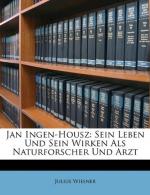|
This section contains 265 words (approx. 1 page at 300 words per page) |
World of Biology on Jan Ingen Housz
While working at a London hospital, Ingen Housz became an expert in the technique of preventing smallpox by inoculation. Treatment at that time used a hazardous live virus instead of today's safer vaccine. In 1768, he traveled to Vienna, Austria, to inoculate Austria's royal family. His treatment was so successful that he was appointed court physician and awarded a lifetime income, which he used to finance independent research.
After returning to England in the late 1770s, Ingen Housz began the experiments that led to his discovery of photosynthesis, the process by which plants convert sunlight into food. During photosynthesis, plants absorb carbon dioxide from the air and release oxygen. Respiration is essentially the reverse process--oxygen is used up and carbon dioxide is released. Inspired by Joseph Priestley's research on oxygen, Ingen Housz learned that only the green parts of plants can revitalize air that has been depleted of oxygen, and they do so only in the presence of sunlight. This was the first indication of light's role in plant life. He also discovered that only the visible light of the sun, not its heat, is necessary for photosynthesis. Ingen Housz's research additionally proved that respiration occurs in all parts of the plant, including its roots and flowers. He later discovered that plants produce much more oxygen than they use up, and, subsequently, that animal and plant life are naturally balanced in a system of mutual support.
Ingen Housz also broke new ground in physics and chemistry. For example, he improved phosphorus matches, invented a hydrogen-fueled lighter, and mixed an explosive propellant for firing pistols.
|
This section contains 265 words (approx. 1 page at 300 words per page) |


